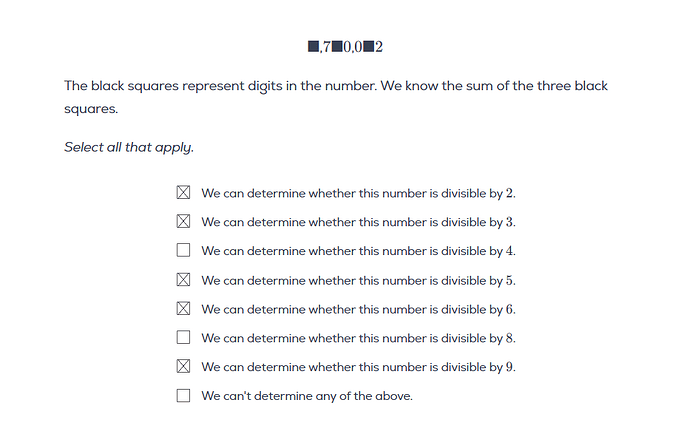I have a problem with a question (Arithmetic Progress Quiz #2 - Question 14). The question says that we know the sum of the three block squares, but we don’t know the exact sum. For example, if the block sum is 18, then the total sum of the number will be 27, which is divisible by 3, 6, and 9. But if the block sum is 17, then it will not be divisible by 3, 6, and 9. So, we don’t know the exact sum, which leads to two possible choices. In any case, we choose divisible by 3, 6, and 9. But why don’t we choose the divisible by 4 and 8 option? These options have two possible choices too (the tens digit is 2 or 3).
In my opinion, the question is like, “The black squares represent digits in the number. We know the sum of the three black squares, which is multiple of 9;” then it will be perfect for those options.
That’s correct yeah.
That’s also correct.
It’s about the word “whether”.
We can determine whether this number is divisible by 3
This means:
We would be able to tell IF the number is divisible by 3 or not
It does not mean:
We can determine THAT the number IS divisible by 3.
In this case, the divisible by 4 and 8 option is true too. Because if the tens digit is 3 or 7, then the number will be divisible by both 4 and 8. In the other case, it is not divisible by both 4 and 8. So it leads to two possible scenarios: that we would be able divisible by 4 and 8 or not, because in the option it has the whether word too.
Yeah but you don’t know the tens digit black square specifically, you’ll only be told the sum of the 3 black squares.
In the tens digit black square, there are 10 different digits that can be placed (0, 1, 2, 3, 4, 5, 6, 7, 8, 9). There are two possible solution whether it is divisible by 8/4 or not divisible by 8/4. The answer choices say whether," too. So why am I not choosing it?
I ask chatgpt and chatgpt shows this.
We are given a number with three unknown digits represented by black squares: ■, 7■0,0■2, and told that the sum of the three black squares (digits) is known.
Goal:
Select all the divisibility checks we can determine based only on the known digits and the sum of the black squares.
Let’s define:
- The number is of the form A,7B0,0C2
- We are told the sum A + B + C is known, but not the actual values of A, B, or C.
Step-by-step analysis for divisibility:
Divisible by 2:
- A number is divisible by 2 if its last digit is even.
- The last digit is 2, so it’s even.
 We can determine divisibility by 2 → Yes
We can determine divisibility by 2 → Yes
Divisible by 3:
- A number is divisible by 3 if the sum of all its digits is divisible by 3.
- We don’t know all digits (only know sum of 3 unknowns), so we cannot determine total sum.
 No
No
Divisible by 4:
- A number is divisible by 4 if the last two digits form a number divisible by 4.
- Last two digits are C2, but we don’t know C, so cannot determine.
 No
No
Divisible by 5:
- A number is divisible by 5 if the last digit is 0 or 5.
- Last digit is 2, so not divisible by 5.
 We can determine divisibility by 5 → Yes
We can determine divisibility by 5 → Yes
Divisible by 6:
- A number is divisible by 6 if divisible by both 2 and 3.
- Divisible by 2
 but 3
but 3  (we don’t know).
(we don’t know).
 No
No
Divisible by 8:
- A number is divisible by 8 if last three digits form a number divisible by 8.
- Last 3 digits are 0C2, unknown.
 No
No
Divisible by 9:
- A number is divisible by 9 if the sum of all digits is divisible by 9.
- Same issue as 3: we don’t know total sum.
 No
No
We can’t determine any of the above:
- Not true — we can determine for 2 and 5.
 No
No
 Final Answer (check the boxes for):
Final Answer (check the boxes for):
 We can determine whether this number is divisible by 2.
We can determine whether this number is divisible by 2. We can determine whether this number is divisible by 5.
We can determine whether this number is divisible by 5.
Not sure if you should be using chatgpt for the verification process, but suppose I tell you that the sum of the three black squares is 17.
Could you then definitively tell me if the resulting number is:
- Divisible by 2?
- Divisible by 3?
- Divisible by 4?
- Divisible by 5?
- Divisible by 6?
- Divisible by 8?
- Divisible by 9?
Your answer to this question is also the answer to your main question.
Also, your chatgpt response states, “so we cannot determine total sum.” However, this is obviously false because the total sum can be computed – as you might know how to do.
